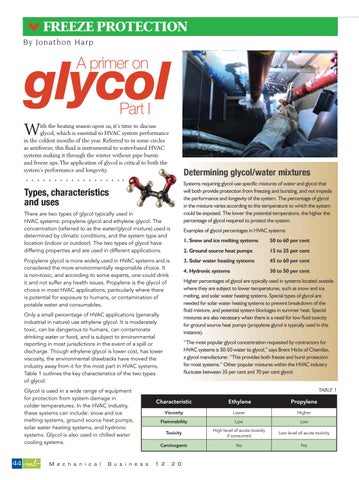FREEZE PROTECTION By Jonathon Harp
glycol A primer on
Part I
W
ith the heating season upon us, it’s time to discuss glycol, which is essential to HVAC system performance in the coldest months of the year. Referred to in some circles as antifreeze, this fluid is instrumental to water-based HVAC systems making it through the winter without pipe bursts and freeze ups. The application of glycol is critical to both the system’s performance and longevity.
Types, characteristics and uses There are two types of glycol typically used in HVAC systems: propylene glycol and ethylene glycol. The concentration (referred to as the water/glycol mixture) used is determined by climatic conditions, and the system type and location (indoor or outdoor). The two types of glycol have differing properties and are used in different applications. Propylene glycol is more widely used in HVAC systems and is considered the more environmentally responsible choice. It is non-toxic, and according to some experts, one could drink it and not suffer any health issues. Propylene is the glycol of choice in most HVAC applications, particularly where there is potential for exposure to humans, or contamination of potable water and consumables. Only a small percentage of HVAC applications (generally industrial in nature) use ethylene glycol. It is moderately toxic, can be dangerous to humans, can contaminate drinking water or food, and is subject to environmental reporting in most jurisdictions in the event of a spill or discharge. Though ethylene glycol is lower cost, has lower viscosity, the environmental drawbacks have moved the industry away from it for the most part in HVAC systems. Table 1 outlines the key characteristics of the two types of glycol. Glycol is used in a wide range of equipment for protection from system damage in colder temperatures. In the HVAC industry, these systems can include: snow and ice melting systems, ground source heat pumps, solar water heating systems, and hydronic systems. Glycol is also used in chilled water cooling systems.
44
M e c h a n i c a l
B u s i n e s s
Determining glycol/water mixtures Systems requiring glycol use specific mixtures of water and glycol that will both provide protection from freezing and bursting, and not impede the performance and longevity of the system. The percentage of glycol in the mixture varies according to the temperature to which the system could be exposed. The lower the potential temperature, the higher the percentage of glycol required to protect the system. Examples of glycol percentages in HVAC systems: 1. Snow and ice melting systems
50 to 60 per cent
2. Ground source heat pumps
15 to 25 per cent
3. Solar water heating systems
45 to 60 per cent
4. Hydronic systems
30 to 50 per cent
Higher percentages of glycol are typically used in systems located outside where they are subject to lower temperatures, such as snow and ice melting, and solar water heating systems. Special types of glycol are needed for solar water heating systems to prevent breakdown of the fluid mixture, and potential system blockages in summer heat. Special mixtures are also necessary when there is a need for low fluid toxicity for ground source heat pumps (propylene glycol is typically used in this instance). “The most popular glycol concentration requested by contractors for HVAC systems is 50-50 water to glycol,” says Brent Hicks of Chemfax, a glycol manufacturer. “This provides both freeze and burst protection for most systems.” Other popular mixtures within the HVAC industry fluctuate between 35 per cent and 70 per cent glycol. TABLE 1
Characteristic
Ethylene
Propylene
Viscosity
Lower
Higher
Flammability
Low
Low
Toxicity
High level of acute toxicity if consumed
Low level of acute toxicity
Carcinogenic
No
No
1 2 . 2 0








